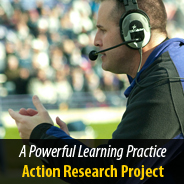Many of our team members also serve on Penn Charter’s Technology Advisory Group and the Teaching and Learning Committee. In both of these groups, there has been on-going discussions about what would be the most successful model for meaningful professional development at Penn Charter. We seized upon the idea of working with individuals who were not necessarily strong in technology but who might be interested in 21st-centurizing their teaching, with a “coach” or mentor to guide them. We envisioned a grass-roots type of professional development, where those mentored would agree that they would Pay It Forward, coaching another colleague on how to 21st-centurize a lesson using what that they learned.
We wanted to work with 7 faculty members on a 1:1 basis, with each team member serving as a mentor/coach as the faculty member “21st-centurized” a lesson. The goal was for that faculty member to then “Pay it Forward” by sharing what they had learned with another faculty member. We would measure success by seeing whether the mentored teacher did indeed share what they’d learned with another.
The cohort presented its C3 model to Penn Charter’s administration, including a request for release time. With approval of the proposed program, faculty members were solicited in December and projects were approved by January 2011. Team members began working individually with their partner faculty members in January and continued working through April 2011. The cohort felt it would be useful to use the CFG protocols to present the program and solicit feedback and suggestions; a CFG meeting was scheduled for March. The cohort was requested to present the collaborative projects to the entire faculty in April.
All of the current PLP cohort are interested in participating in Year Two at this point, which speaks to the value of the PLP model. We really enjoyed being together and felt that we, both individually and as a group, learned from the experience and found it to be energizing and rewarding. Collaboration across divisions and departments highlighted the value of relationships in developing the C3 model.
Although release time was approved for both the cohort members and their partners, it was not used as most partners found they could take advantage of free periods in their schedules. Nonetheless, finding face-to-face time for the cohort to meet and to meet with their respective “mentees” was one of the the more challenging aspects of the project. The collaborative projects turned out to be very organic, developing over time. While most of this year’s projects will conclude during this last trimester, some of the projects involving Skype and contact with students in other countries will not be completed this year. We hope to fully implement the lessons next year. One of the most important findings to come out of this project was the need to better define expectations, establish rubrics, and have the “mentees” provide some sort of final review or assessment.
Team member Sheila Ruen represented the PLP cohort in the CFG meeting and members of Penn Charter’s Committee for Teaching & Learning provided thought feedback and suggestions for enriching the C3 model. The PLP Cohort, working with the Committee for Teaching & Learning, will continue to look for ways to broaden and strengthen the C3 model. The cohort presented the C3 collaborative projects to the entire faculty in March and a number of faculty members expressed interest in participating next year as part of a Penn Charter Cohort. Since then, other faculty have also expressed an interest in also participating as a Pay It Forward “mentee.”
We will not know if our Pay It Forward model will be successful until some time in the coming year; however, interest in next year’s PLP program seems to be a good indicator that this kind of “grassroots” professional development model could be successful.
Some lessons learned doing the project…
– Progress isn’t linear: My partner and I would have a string of meetings where we focused on the same part of his project taking the time needed to learn skills needed to make it work. There were times where one meeting would jump us way forward in how the project was shaped.
– Presenting focuses attention and leads to sharing – My work with Bob got added focus when we knew that the PLP team was presenting to the full faculty and when he was getting ready for a Math Dept meeting.
– Web shifts can be a barrier to progress and stability is a support: A leading web tool looked liked the best one to use for our project but news about it possibly being shut down spooked my partner and we ended up taking us a different direction that was less innovative but more likely to stay working over time.
– Partnering over time made a safe and ongoing space for learning skills: My partner didn’t have to be self-conscious about asking the same question the number of times he needed to learn a skill. He knew I would answer and be around to answer again if needed. This way key to the way he was able to master difficuly, multi-step techniques key to making his project work.
– My own ideas for solving problems can inform my partner but need to take a back-seat to his ideas to be a productive partnership.: It took careful listening and asking clarifying questions to make sure the project met my partner’s needs rather that be something built the way I would build it. The more it met his needs, the more motivating it was for my partner to continue with it.
– Success leads to more success: As my partner found success with his project, it led to him applying for and getting sabbatical time to continue his work.
The team has compiled a lengthy list of resources, examples, and documentation of their project. You can find the list on the
team’s wiki page.


